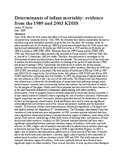| dc.description.abstract | Since 1948, when the first census was taken in Kenya, infant mortality estimates have been computed from numerous sources. Until 1989, the estimates have shown considerable declines in mortality in general and infant mortality in particular over the years. For example, while an infant mortality rate of 184 deaths per 1000 live births was estimated from the 1948 census, this had declined substantially to 83 deaths per 1000 live births in 1979 and then to 60 deaths per 1000 live births in 1989 (CBS, 1993). Estimates from the 1999 Census and the KDHS 1993, 1998, and 2003 show that infant mortality has increased in Kenya between 1989 and 2003, that is, hom 60 to 77 deaths per 1000 live births. Therefore, this study seeks to investigate on the
determinants of infant mortality between these two periods.
The main objective of this study was to analyse the determinants of infant mortality; by looking at the period of rapid decline (1989) and period of upsurge (2003). Specifically, this study seeks to explore the socioeconomic, maternal and environmental factors that have influenced infant mortality, Data from the 1989 and 2003 KDHS was utilised in this study. The total number of births was 6,980 and 5,949 in 1989 and 2003 KDI-IS, respectively. Out of these births, 436 infants in 1989 KDHS and 404 in 2003 KDHS died before celebrating their first birthday.
In 1989, the proportion of infants dead was 6 per cent whereas in 2003 it was 7 per cent of the total births, The Mosley and Chen framework was utilized since it allows for the identification of major behavioral pathways through which socioeconomic, maternal and environmental factors may enhance the survival status of infants. For the purpose of this paper, Mosley and Chen's proposal has been selected for three reasons: it is the most frequently referenced in subsequent papers dealing with infant mortality determinants; it tries to integrate research methods employed by social and medical scientists; it is also closely related to Caldwell's theory regarding the role of mother's education.
Multivariate logistic regression was used. Descriptive statistics generated showed the distribution of women by their key background characteristics. Cross tabulations were used to show any significant relationships that exist between each of the various independent variables and the dependent variable. To determine whether these associations are statistically significant, a Chi-square test was used to measure the dependence 01' the association. The Chi-square also showed if any two variables of cross tabulations were independent.
in 1989, bivariate analysis indicated that there was a significant relationship between maternal education, region of residence, work status of the mother, birth interval, maternal age at first birth, source of drinking water, and presence of toilet facility and infant mortality.
Similarly, in 2003, bivariate analysis indicated that there was a significant relationship between maternal education, region of residence, birth order, and birth interval. In 1989, a higher risk of mortality was associated to infants born to mothers whose age at first birth was less than 20 years and living in HMR (l Iigh Mortality Region). In 2003, a higher risk of mortality was associated to infants born in a birth interval of less than 24 months and in the fourth birth order and above. Likewise, higher risks of mortality were associated to infants borne to mothers with no education in both 1989 and 2003.
This study indicates that maternal education, region of residence, birth order, and birth interval were found to have significant impact on infant mortality. There is need, therefore, to scale up intervention strategies directed at providing education, especially secondary education and above to girls as future mothers, reduction of the regional disparities in infant mortality, low order births, and births at wider intervals (greater than 24 months ). | en_US |

